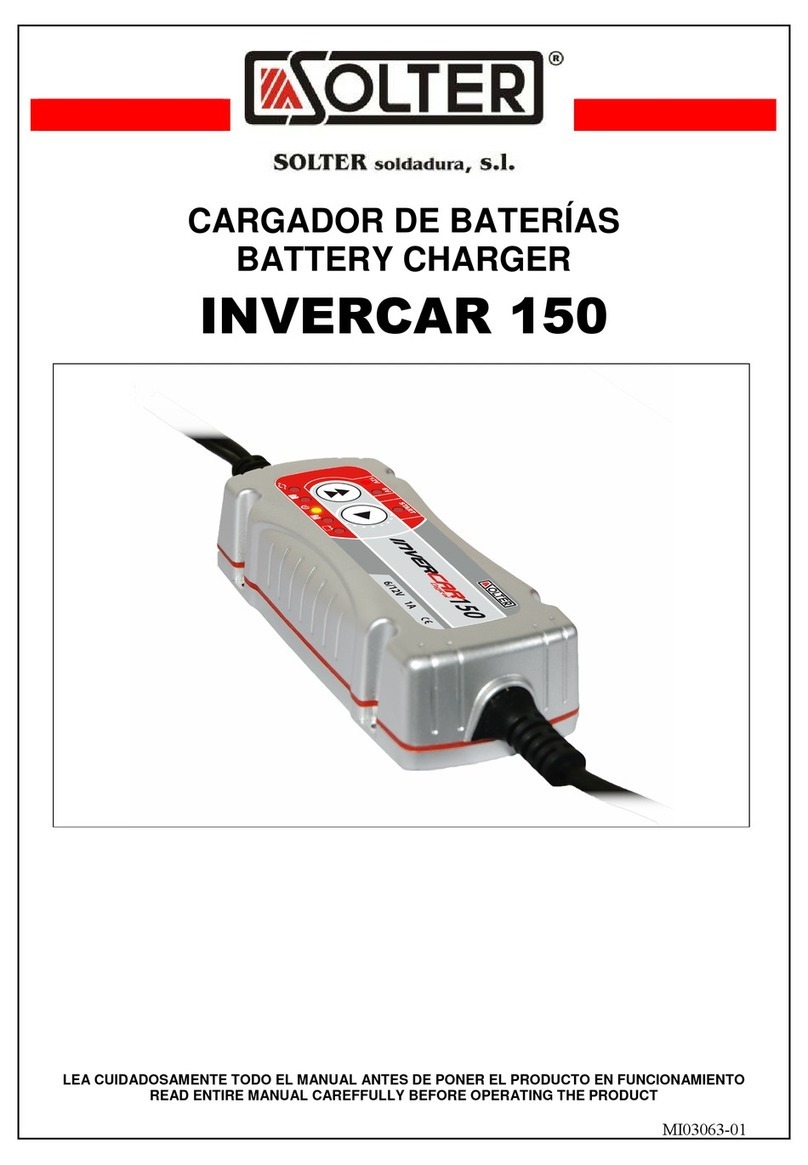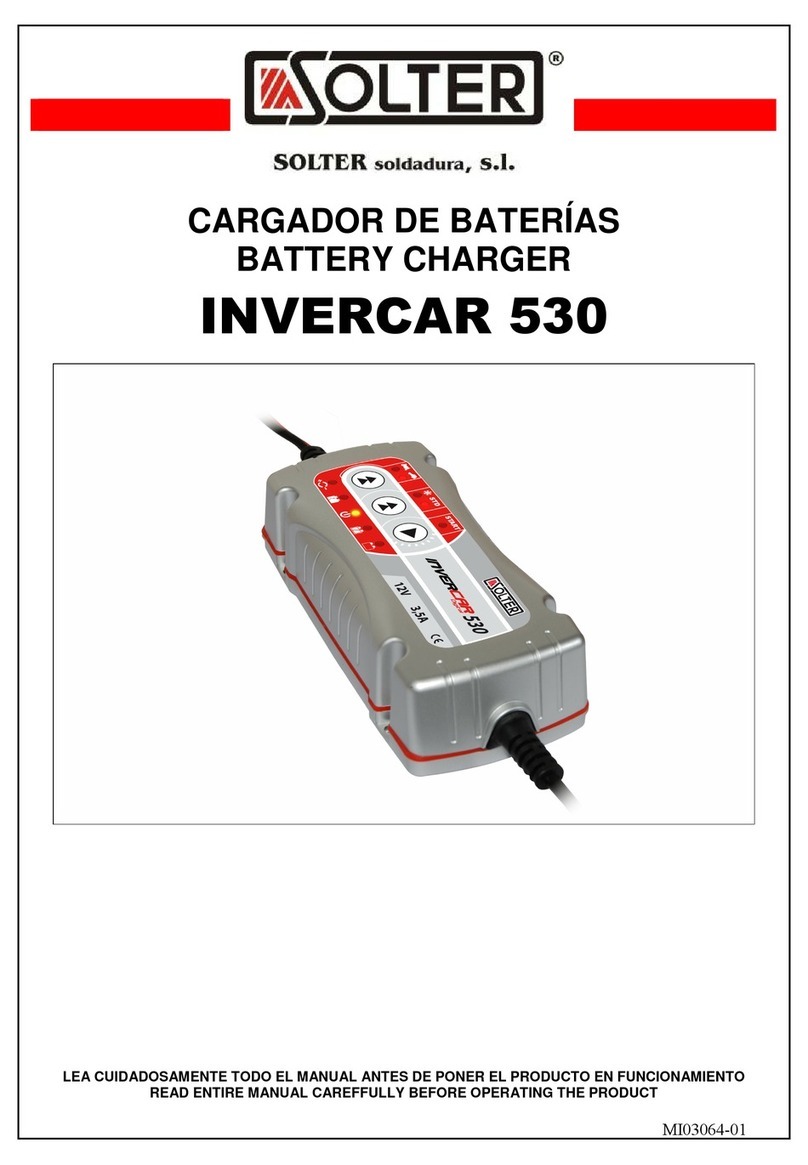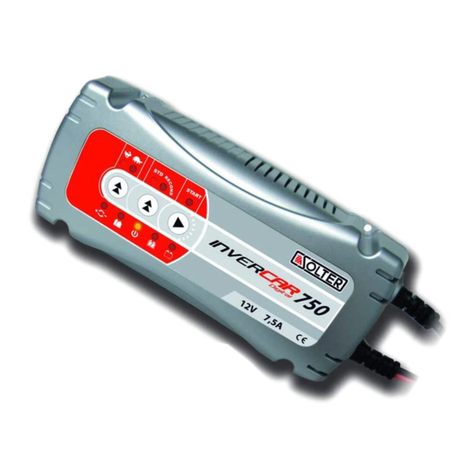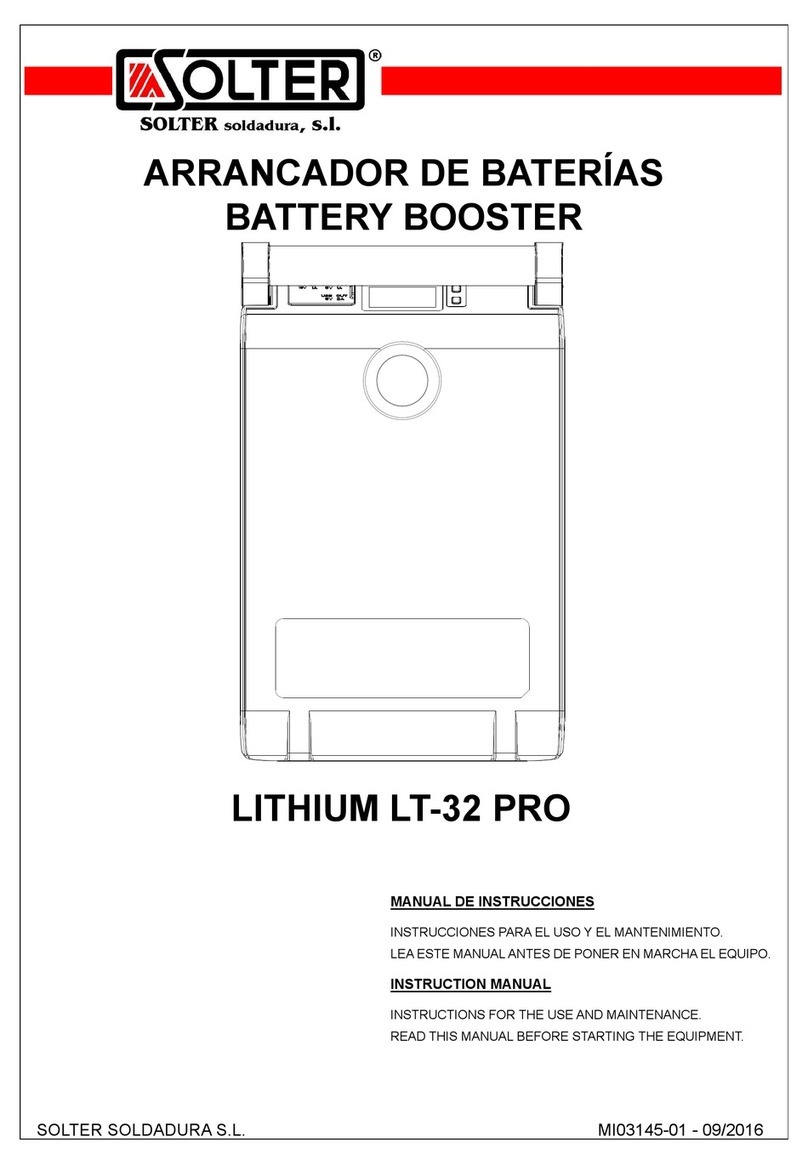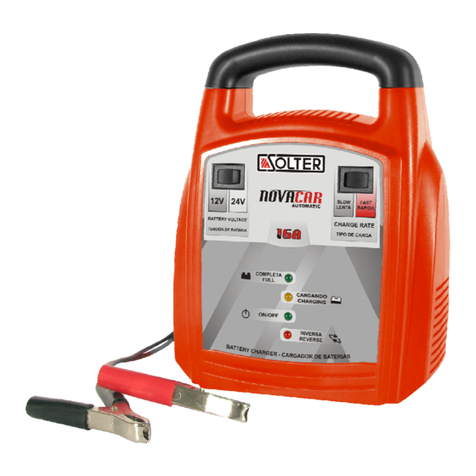Solter SMARTCAR 1500A User manual

1
CARGADOR INTELIGENTE DE BATERÍAS
INTELLIGENT BATTERY CHARGER
CARREGADOR DE BATERIAS INTELIGENTE
15A RMS (10A DC)
SMARTCAR 1500A
Adecuado para todo tipo de baterías de plomo ácido entre 20-200Ah
Suitable for 12V Normal Lead Acid batteries with capacity between 20-200Ah
Adequado para todo o tipo de baterias de chumbo/àcido entre 20-200Ah

8
NFC 1500 intelligent battery charger with 12-bit AD microprocessor.
xCharges with 12V, 10/6/2 a dc (15/9/3 a RMS)
xSelf-identifying multi-stage characteristics charging curve
READ THESE INSTRUCTIONS BEFORE USE AND RETAIN FOR FUTURE REFERENCE.
Soft start tests the battery condition. Severely discharged batteries need the soft start step. The
charging starts with a reduced current until the voltage reaches 10V.
Bulk is the main step where most of the charge is returned (60-80%). The charger delivers maximum
current until the terminal voltage has risen to the set level of 14,2V for Normal battery selection and
14.0V for Gel battery selection.
Absorption completes the charge up to virtually 100% at a constant voltage. The current tapers off
after the current reached the minimum level.
Float is maintenance charge at constant voltage, keeping the batteries at 100% charge. Normal
charging mode is time-limited (max. 10 days) while Supply mode goes on indefinite without damaging
the battery.
SPECIAL FEATURES
Temperature Control Fan
To protect the charger from overheating, a fan is included for heat dispensation. Also to
increase the life span of the fan, a sensor will control the on off the fan, where the fan
will not use when the HFC is not in a hot condition.
Temperature Compensation
A sensor will automatically adjust the charging voltage if the temperature deviates
between -20ºC to +50ºC. At a high temperature environment the unit lowered the output
voltage and at a freezing condition, the unit will adjust a higher output voltage.
Voltage compensation
Because of some voltage drop in the cables, the actual voltage at the clamps of the
battery can be lower than the charger output voltage. A special circuitry inside the unit
will monitor the true input voltage to the battery and adjust the output voltage of the
unit accordingly. This will maximize the charging efficiency.
Buzzer Warning
A built in buzzer will help to warn the user when connect the clamps to the battery
wrongly.
Display
xReverse Polarity – Reverse Polarity Connection to Battery Pole.
xBattery Fault – Faulty Battery Indicator
xCharging – While Battery is charging.
xFull Charge – When Battery is Fully Charged and in Maintenance Mode.
x3 x 7 Segment LED’s Display for Charging Current, Battery Voltage, & Charging %.
Cable Management
The NFC Series casing is designed with AC and DC cables storage comportment. This will
help to avoid cable damage and subsequently any possible danger to user.
INTRODUCTION

9
PROTECTIONS
xFull protections against sparks
xShort circuit protection
xVoltaje compensation
xOverheating protection
xPolarity reversal protection
GASES
When the NORMAL/LEAD ACID battery is being charged you may notice bubbling in the
fluid caused by the release of gas. As the gas is flammable no naked lights should be
used around the battery.
During charging the battery, the charging must be places at a well ventilated area.
Because of the risk of explosive gas, only connect, and disconnect, the battery leads
when the mains supply is disconnected.
Types of Batteries
This charger is only suitable for the specified batteries and should not be used to
recharge non-rechargeable, NICAD or any other type of battery.
Point of Notes
When not in use, the battery charger must be kept at a dry area to avoid moisture. Keep
away from any liquid, rain or snow at all times.
This battery charger is not designed as a caravan lead acid battery charger or power
supply.
This battery charger is not designed for installation on to the vehicle as a fixture.
Danger
Avoid getting ELECTROLYTE on you skin or clothes. It is acidic and can cause burns. If
this occurs you shall rinse the affected area with water immediately.
Never charge a frozen battery. If battery fluid (electrolyte) becomes frozen, bring battery
into a warm area to allow battery to thaw before you begin charging. Never set a battery
on top of charger or vice versa.
Do not touch the battery clamps together when the charger is on.
Never operate charger if it has received a hard blow, been dropped, or otherwise
damaged. Take it to a qualified professional for inspection and repair.
Be sure to position the charger power cord to prevent it from being stepped on, tripped
over, or damaged.
Never pull out the plug by the cord when unplugging the charger. Pulling on the cord
may cause damage to the cord or the plug.
If the supply cord is damaged, it must be replaced by the manufacturer, its service agent
or similarly qualified persons in order to avoid a hazard.
If the battery needs to be removed from the vehicle before charging, always remove the grounded
terminal from the battery first, also ensure that all accessories in the vehicle are tuned off to prevent
arcing.
Ensure that the surrounding area is well ventilated to allow dispersal of toxic fumes or gases.
Ensure the battery terminals are clean. If the battery has a removable vent cap, top up each battery
cell with distilled water to the level recommended by the battery manufacturer, do not overfill.
IMPORTANT SAFETY INSTRUCTIONS
PRE-CHARGE CHECKLIST

10
If the battery does not have caps, refer to the manufacturer’s instructions regarding charging and
charging rates.
Connection
1. Connect the DC Clamps to the battery poles in the following order:
2. Connect the positive charging lead (RED) to the positive terminal pole of the battery
(marked P or +).
3. Connect the negative lead (BLACK) to the negative pole of the battery (marked N or -).
4. It is important to ensure that both DC Clamps are making good contact with their
respective terminal poles.
Control Panel
1. Charge Rate Button sets the charge rate to one of the following:
2A DC Slow - Intended for charging small batteries such as those commonly used in garden
tractors, snow mobiles and motorcycles. The 2A rate is not intended to be used as a trickle
charger for larger batteries.
6A DC Normal - Use for charging automotive batteries, marine batteries, and deep cycle batteries
at a normal rate.
10A DC Fast - Use for charging automotive batteries, marine batteries, and deep cycle batteries
at a fast rate.
2. Battery Selection Button sets the type of battery to be charged to one of the following:
GEL CELL / SLA – All type of “gel cell” & “SLA” type battery.
Regular – All type of “lead acid” battery, sealed or non-seal.
OPERATING INSTRUCTIONS

11
3. Mode Display sets and shows one of the following reading:
Output current – This shows the selected charging current.
Battery voltage –This shows the voltage of the battery in DC.
Charging % –This shows an estimate percent of charge.
With the exception of gel cell and calcium batteries, all other battery types may or may not have vent
caps. Vent caps are located on top of the battery and provide a means to add distilled water when
needed.
Batteries should be marked with their type. If charging a battery that is not marked, check the
manual of the item that uses the battery. If the battery type is unknown, use the “Gel Cell /
SLA” setting.
Charging
Insert the AC plug into the mains supply (220-240 Volts AC only).
The battery charger is now in the stand-by mode with the default choice of
Battery - “Gel Cell / SLA”
Current – “2A DC Slow”
If the Start Charging Button is now pressed, the charger will immediately go into the 2A DC, Gel Cell
battery charging mode.
For alternative selection, please follow the following steps:
Step1 – Press the Charge Rate Button to pick the battery type for charging.
Step 2 – Press the Battery Selection Button to pick the charging power.
Step 3 – Press the Start Charging Button to start the charging process.
On the front panel there are also 4 LED indicators for the following function:
1. Reverse Polarity – The DC Clamps have been connected at the wrong pole on the battery.
Simply disconnect and reconnect the DC clamps at the correct pole, restart the charging
process.
2. Battery Fault – When this is light, this mean the battery can be broken. If the battery fault
display persists after resetting the charger, the battery may be faulty. Please consult a nearby
battery service centre.
3. Charging –This shows the battery is in charging process.
4. Full Charge – This shows the battery is fully charged and the battery charger is in
maintenance mode.
LED INDICATORS
Table of contents
Other Solter Batteries Charger manuals
